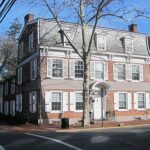Francis Hopkinson House
 The Francis Hopkinson House is an historic house in Bordentown.
The Francis Hopkinson House is an historic house in Bordentown.
It is a 2+1⁄2-story brick building, covered with a gambrel roof. Its main facade is five bays wide, with a center entrance sheltered by a rounded hood supported by decorative Italianate brackets. Sash windows are arranged symmetrically around the entrance, and the steep slope of the gambrel roof is pierced by three dormers with rounded tops echoing to entrance hood in style. The interior of the house has been stylistically altered, although its basic floor plan is little altered.
The house was built in 1750 by Joseph Imlay, a local merchant. Francis Hopkinson, a lawyer native to Philadelphia, moved here in 1774. Hopkinson was one of the signers of the Declaration of Independence as a delegate from New Jersey. He was also the first American-born composer of secular music. During the American Revolution, Hopkinson designed Continental currency, departmental seals, and most of the elements in the Great Seal of the United States. He later served as a federal judge in Pennsylvania. He lived in this home with his wife Ann Borden (1747-1827) from 1774 until Hopkinson’s death in 1791. Ann Borden was the granddaughter of Joseph Borden, the founder of Bordentown, New Jersey.
The house was to be burned by the British during a military action in 1778, but was spared by a Hessian officer’s appreciation of Hopkinson’s library. The house remained in the Hopkinson family until 1915. It has since seen mixed residential and professional use. The house was designated a National Historic Landmark in 1971.
